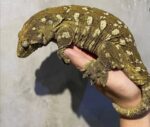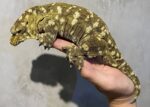Description
Rhacodactylus leachianus, commonly known as the New Caledonian giant gecko for sale, Leach’s giant gecko, leachianus gecko, or Leachie, is the largest living species of gecko and a member of the family Diplodactylidae. It is native to most of New Caledonia.
Taxonomy of New Caledonian Giant Gecko For Sale
The specific name, leachianus, is in honor of English zoologist William Elford Leach. Historically, there have been three recognized subspecies of R. leachianus (including the nominotypical subspecies): R. l. aubrianus, R. l. henkeli (first described by Seipp and Obst in 1994), and R. l. leachianus. However, based on recent molecular data, no populations of R. leachianus are granted subspecies status at the present time. Instead, locality based morphotypes are used to distinguish populations of R. leachianus.
Description of New Caledonian Giant Gecko For Sale

R. leachianus is the largest extant gecko in the world and is considered an example of island gigantism. R. leachianus of the Grande Terre localities are capable of growing 14–17 inches (360–430 mm) long, with a weight range between 250 and 500 grams.
New caledonian giant gecko for sale of the Insular localities are capable of growing 9–12″ (23–30 cm) long, and weighting between 150 and 300 grams. It has a heavy body, loose skin, and a small, stumpy tail. It is variable in color, coming in shades of mottled green, gray, and brown, sometimes with highlights of white, orange, and/or pink.
It was only exceed in size by the now extinct Gigarcanum delcourti known from a single specimen 50% longer and probably several times heavier than the largest R. leachianus specimens, which also originated from New Caledonia.
Distribution and habitat of New Caledonian Giant Gecko For Sale
R. leachianus is found in all of the southern and eastern portions of the main island of New Caledonia, as well as on several of the smaller islands in the group. Topographical and ecological differences observed at each locality may have contributed to the phenotypical and morphological differences seen in R. leachianus. The insular locality of Duu Ana is thought to no longer have an extant population of R. Leachianus.
Biology of New Caledonian Giant Gecko For Sale

R. leachianus is an arboreal species; it is primarily nocturnal and remains hidden in tree hollows during the day. it has a diet that includes insects, spiders, small vertebrates, fruit, nectar, and sap.
The most common component of R. leachianus diet consists of the fruit from Cassine curtipendula, a small fruit with a large seed that is often seen in fecal matter. It is speculated that the elongated snouts of mainland locality R. leachianus suggest a diet model that contains more vertebrate and insect matter than their insular locality counter-parts. Records of cannibalism among R. leachianus have been recorded, but this phenomenon could be attributed to territorial defense. These giant geckos can climb vertically up glass surfaces.
This is due to adhesive pads on their feet called lamellae, which are made up of tiny hairs which increase friction force when applied to surfaces. R. Leachianus also possess large claws that aid in climbing as well. R. leachianus are capable of dropping their tail, a self-amputation process known as autotomy.
Unlike Correlophus cilliatus, New Caledonian Giant Gecko For Sale are capable of tail regeneration through a process known as epimorphosis. Males and females of R. leachianus display differentiating morphological characteristics known as sexual dimorphism.
Male R. leachianus display a hemipenal bulge at the base of the tail, whereas females do not have this bulge. R. leachianus is observed to have temperature dependent sex determination. In captivity, eggs with a sustained incubated at 85 °F will often result in male offspring, and eggs that have a sustained incubation temperature of 72 °F (22 °C) will result in female offspring.














Reviews
There are no reviews yet.